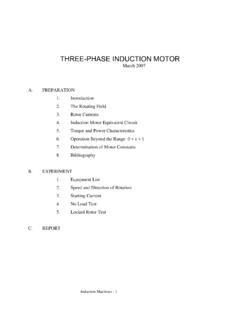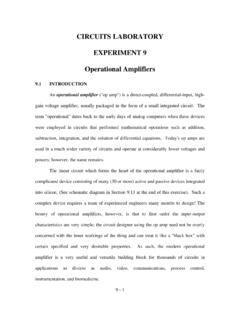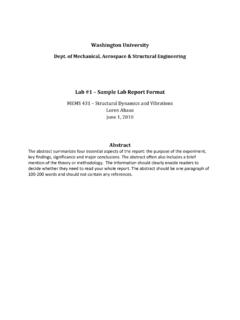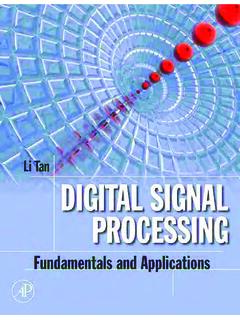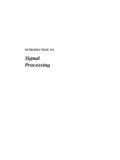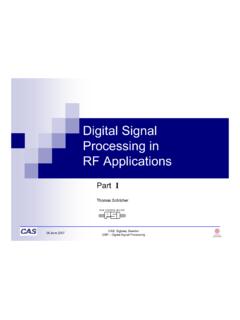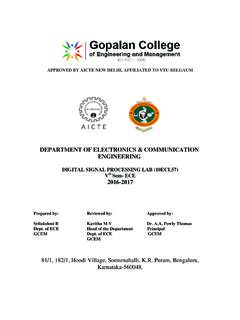Transcription of INTRODUCTION TO DIGITAL SIGNAL PROCESSING
1 INTRODUCTION TO DIGITAL SIGNAL PROCESSING by Dr. James Hahn Adjunct Professor Washington University St. Louis 1/27/11 12:02 PM 2 INTRODUCTION Purpose/objective of the course: To provide sufficient background on DIGITAL SIGNAL PROCESSING (DSP) concepts so students can understand and use commercial software for DSP and use DSP for research projects. Detailed manual design procedures will be covered only to the extent necessary to use the available software. DIGITAL SIGNAL PROCESSING What do we mean by DIGITAL SIGNAL PROCESSING ? DIGITAL - means discrete in nature the SIGNAL levels are chosen from a finite set of levels, as opposed to continuous or analog signals, which can have an infinite number of levels.
2 In practice, DIGITAL nearly always means binary, that is, two-level signals our standard TTL or CMOS levels as used in computers and other DIGITAL systems. Note that signals used in DSP systems may be developed from analog signals by sampling and analog-to- DIGITAL conversion (discussed at some length in a later section) or may be available as DIGITAL signals initially, as from another DIGITAL system. DSP signals are also discrete in time, they represent samples taken at specific instants in time. Thus, we use notation like x[n] or y[n] to represent these signals, where n is an integer that represents, effectively, the sample number. SIGNAL means some physical quantity whose variations convey information.
3 A SIGNAL can be mechanical, hydraulic, pneumatic, optical (visible, UV or infra-red light), temperature, etc. However, we generally deal with electrical signals, either because they were initially developed as electrical, or because they have been converted to electrical. PROCESSING refers to the applications we want to implement or operations we want to perform on the DIGITAL SIGNAL . The two major, end-result applications for DIGITAL SIGNAL PROCESSING are DIGITAL filters and the fast Fourier transform (FFT). However, there are innumerable other applications or types of PROCESSING , carried out because they are important in themselves or because they are steps in implementing filters or FFTs.
4 SYSTEM PROPERTIES: To simplify the work and to allow the use of the many standard design techniques, we will make certain assumptions about the properties of the systems we will deal with. 3 Linearity Linearity dictates that for a single input, the output is proportional to the input, and for two or more inputs, the output must be the sum of the individual responses of the two inputs. Mathematically, this is expressed as: if x1[n] produces y1[n], and x2[n] produces y2[n], then ax1[n] + bx2[n] produces ay1[n] + by2[n] Linearity is the basis for the concept of superposition and for convolution which we will see shortly. Time-invariant. We assume the system properties do not vary with time (or at least over the time period we are concerned about.)
5 Causality. Causality implies that output changes do not occur before input changes. Although this cannot happen in a real situation, non-causal considerations sometimes arise in theoretical derivations. If all the samples for a certain SIGNAL have been collected and stored, causality is not an issue, since all samples both before and after a selected value of n are available. In addition, any non-causal SIGNAL can be made causal just by delaying all the samples by an appropriate amount. Most real signals and systems we deal with are causal, but just as an example we will look at one non-causal system. To that end, consider the moving-average system, frequently used to smooth a set of data points.
6 The moving average system computes the average of a certain number of points around a specific point, then replaces the value at that point with the average. Thus, a typical moving average computation might be to take the average of the two points prior to a certain point, plus the point itself, and the two points past the point in question. Thus, the computation for point n requires data from the points numbered n+1 and n+2, which obviously aren t available at time n. However, if the data consists of stored points, the average can easily be computed. There are other important properties of DSP systems, such as stability (every bounded input produces a bounded output). We will assume these, but not discuss any further.
7 4 SAMPLED SIGNALS AND SEQUENCES Let us now consider the nature of the signals used in DIGITAL SIGNAL PROCESSING . These signals are frequently, but not always, developed by sampling a continuous-time SIGNAL . Sometimes they are called discrete-time signals, to reflect the fact that they have meaning only at discrete points in time. Sampled signals are also discrete in amplitude as well as time, since the normal analog to DIGITAL conversion process is finite in its resolution, and thus forces the amplitude to be chosen from a finite set of values. If we call the sampled SIGNAL x[n], to indicate that the values of the SIGNAL are a function of the sample number or index n , then the individual values of the SIGNAL are represented by x[0], x[1], x[2], etc.
8 , as shown by the following: Note that the index n can be negative as well as positive, to indicate that the SIGNAL sample was taken before the point designated n=0. This is not really a complication, since the definition of n=0 is frequently arbitrary. Since the DIGITAL signals represent samples of continuous-time signals, taken at discrete points in time, they are actually a set of numbers representing the values of the continuous-time SIGNAL at the instants in time at which it was sampled. For example, typical sequences might be: 1,2,3,4,5 or 2, -4, -6, 8 or , , , , etc. Thus we have to get accustomed to the idea that the DIGITAL signals we deal with are just a string or sequence of numbers.
9 In fact, they are usually referred to as sequences instead of signals. This string or sequence of numbers is handled just like any other set of numeric data: it can be treated as a vector, stored in an array format, manipulated by a spread sheet, etc. A sequence is frequently called a vector, although it has no physical meaning like a force vector or electromagnetic field vector does. 1 2 3 4 5 6 n -6 -5 -4 -3 -2 -1 x[0] x[1] x[-3] ORIGINAL ANALOG SIGNAL 5 It is also quite possible that the sequence of numbers was not derived by sampling a continuous-time SIGNAL They may represent data collected from measurements made in some physical or natural system, such as traffic flow, growth rate of trees, ocean water temperature, etc.
10 , which actually are sampled quantities, but may be the result of intermediate calculations. There are several special sequences used in DSP that are not derived from the sampling of a real-world SIGNAL . Rather, they are defined instead of sampled, and thus have somewhat different notation. The first is the unit impulse. It is designated as [n], and defined as 1 for n=0, and 0 elsewhere. Graphically, it is The unit impulse is particularly important in DSP because DSP signals, being just sequences of numbers, can be represented by a series of impulses, each weighted to represent the actual value of the sequence for each value of n. Thus, DSP system analysis frequently amounts to analysis of the system response to a sequence of impulses individually, and subsequent superposition or addition of the individual responses to find the complete response to the input sequence.
